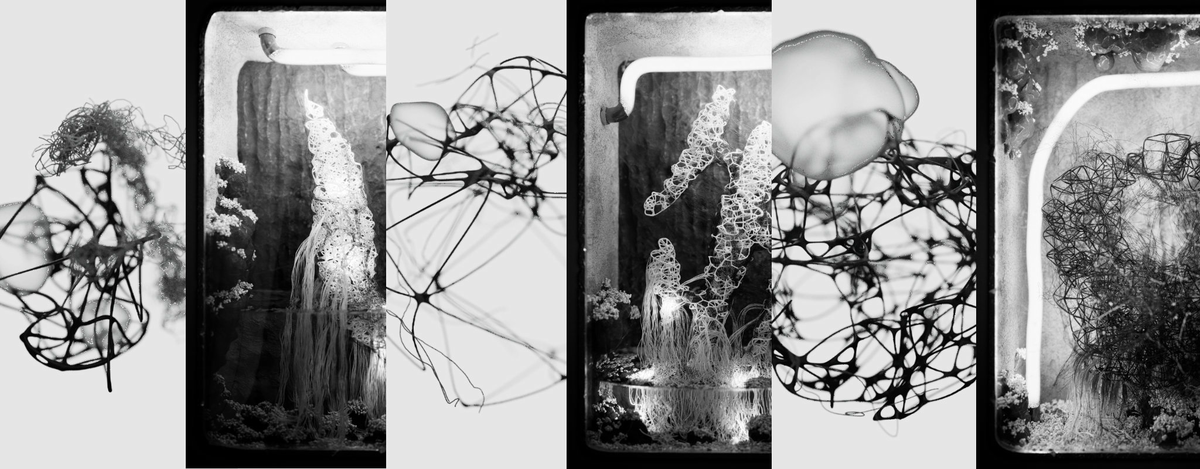
Stories of Sponges and Survival
written by boringold.tez
When I was a kid, I had an encyclopedia of animals. It was a heavy book with thousands of detailed drawings. I often carried it with me and lectured unprepared visitors and family members about its contents. My favourite section was about the giants of the sea and the creatures of the deep. Paweł Grzelak shares my childhood fascination of aquatic life, and his recent projects have an unusual focus on the essence of ancient organisms that are often overlooked despite their uniqueness: sponges.
Sponges are primitive multicellular aquatic animals that belong to the phylum Porifera, meaning 'pore bearer'. They have no organs or tissues, but rely on specialized cells for different functions. Sponges are among the oldest living animals on Earth, dating back to 500 million years ago. They can reproduce both sexually and asexually, and some can regenerate from fragments. Sponges provide habitats for many other organisms and and act as filters enhancing water quality (more info: Wikipedia).
Two interconnected artworks by 3D artist Paweł Grzelak, Gemmules and Symplasma: Experiment, have brought these ancient organisms to my attention.
At the heart of the artwork Gemmules lies an artistic microcosm that tells a story of creation, diversity and resilience. The series derives its title from a biological reference: gemmules, structures produced by certain freshwater sponges during asexual reproduction. These encapsulated clusters of cells demonstrate remarkable survival skills, enduring adverse environmental conditions until favorable circumstances allow them to develop into new individuals. Much like these natural gemmules, Grzelak's digital counterparts can persist as data files in the blockchain's decentralized storage, capable of withstanding local erasure, power outages, and system crashes.
The series consists of 222 individual animated creatures, transforming the wiry skeletons of real sponges into a wildly diverse array of specimens. However, while living sponges are (almost) stationary and can't actively flex their spicules, these black frames resonate with a pulsating vitality. It's as if we glimpse an alternate evolutionary pathway that has yielded sponges capable of such dynamic movement.
The images' shallow depth of field suggests a microscopic view, revealing small bladders or cysts in some specimens and intricate, moss-like growth covering others. The fluid movements remind me of images of coronary angiographies, while the pumping, rhythmical movements prompt contemplations of the concepts of sexual reproduction and life.
Whether stimulating these thoughts was the artist's intention or not, there is an interconnectedness between art and biology in Grzelak's broader body of work that can be seen throughout.
In his preceding, hauntingly beautiful Symplasma: Experiment series, the artist put the spotlight on another kind of Porifera and made ethereal glass sponges the subjects of a virtual "forced evolution" experiment. And spotlight can be taken quite literally here, as the illumination and stark contrasts of the images have a big impact on their appeal. Grzelak portraits the intricately shaped, silicon-based structures of the sponges' skeletons in monochromatic, post-photographic images that emulate the atmosphere of vintage science fiction films and feel so real that we can almost smell the damp, salty air of a remote underground lab. Symplasma: Experiment captivates us with a blend of the cinematic and the miniscule and, with astonishing level of detail, displays water tanks inhabited by marine creatures that look like they come from an alien world. My favourite detail besides the sponges themselves are the strangely bent and warped fluorescent tubes that illuminate the scenes.
Symplasma:Experiment is presented as "the first of a number of Symplasma series," with subsequent projects set to explore "other peculiarities of the phylum," and thus Gemmules emerges as the second chapter of this series, even if unmentioned in the project's description.
Grzelak provides insight into the world of Symplasma: Experiment with these words:
It's not really an alternative world, but rather an extension of ours. I put myself into the shoes of a scientist performing a "forced evolution" experiment on an imaginary underwater sponge species, photographed with an old film camera. Being strongly drawn to underwater exploration footage, I often find myself spontaneously imagining deep-sea landscapes, animals, coral-like forms. Most of my art starts with a quick sketch done just before falling asleep. My creative peak always happens at night. Technically speaking - I enjoy a mix of procedural form generation with a pinch of direct artistic control. In nature, shapes often seem to be perfect at a first glance, mathematical even - like snowflakes. But the closer you look, the more deviations from the formula you notice. Every organism during its growth encounters various difficulties that sculpt it - available space, access to light, type of food or mechanical influence. All of them are distancing it from the ideal it would like to be.
Grzelak's fascination with underwater exploration and the enigmatic deep-sea landscape invites us to contemplate the interplay between form, function, and adversity that shapes organisms. The focus on sponges in Gemmules and Symplasma: Experiment might be surprising, but while these creatures seem unassuming, their ancient lineage, unique biological characteristics, and crucial role in aquatic ecosystems provide rich narrative material for an exploration of life forms that have silently been part of the world we live in (almost) ever since.
The generative process of creating Gemmules and the concept of a witnessed "forced evolution" experiment in Symplasma: Experiment mirror the workings of the forces that have shaped life's diverse forms and prompts us to contemplate our origins and the remarkable journey that has brought us to our present state as yet another animal species.
Both visually and conceptually, these two artworks seamlessly complement one another, unveiling the vivacious, animated gemmules under radiant scientific light, while simultaneously presenting the static, magnificently alien forms of glass sponges within a virtual laboratory that feels as remote and inhospitable as an alien planet.
Sources of additional images:
Orange Sponge by James St. John via Flickr under CC BY 2.0 license
Purple Cup Sponge by icelight via Wikimedia Commons under CC BY 2.0 license